
India overhauls teaching in Himalayan Buddhist monasteries to counter China
The Hindu
India launches first school curriculum for Buddhist monasteries to foster patriotism and insulate religious learning from China's influence.
India is preparing to roll out its first school curriculum for Buddhist monasteries this month, aiming to unify education programmes and foster patriotism in Himalayan religious centers near its border with China.
Home to many ancient monasteries as the birthplace of Buddhism, India received an influx of Tibetans in the 1950s that led to many new institutions being set up, but now it seeks to insulate religious learning from China’s influence.
"We are trying to inculcate Indian identity through education along with Buddhism to make sure China can never control our monasteries in the Himalayas," said Maling Gombu, a Buddhist worker of the ruling Bharatiya Janata Party (BJP).
"Thousands of children living and studying in remote monasteries deserve education recognised and certified by India," added Gombu, one of a team promoting Indian Buddhist traditions and national education in Arunachal Pradesh.
The border state is claimed by China, but New Delhi rejects this.
About 600 monasteries scattered across the northern states of Sikkim, Himachal Pradesh, Uttarakhand, and the regions of Jammu and Kashmir and Ladakh offer training in four types of Tibetan and Indian Buddhist traditions.
They also teach modern subjects and English, but the courses lack consistency outside a national education effort that aims to weld an overarching identity from India's patchwork of languages and religions.





















 Run 3 Space | Play Space Running Game
Run 3 Space | Play Space Running Game Traffic Jam 3D | Online Racing Game
Traffic Jam 3D | Online Racing Game Duck Hunt | Play Old Classic Game
Duck Hunt | Play Old Classic Game











